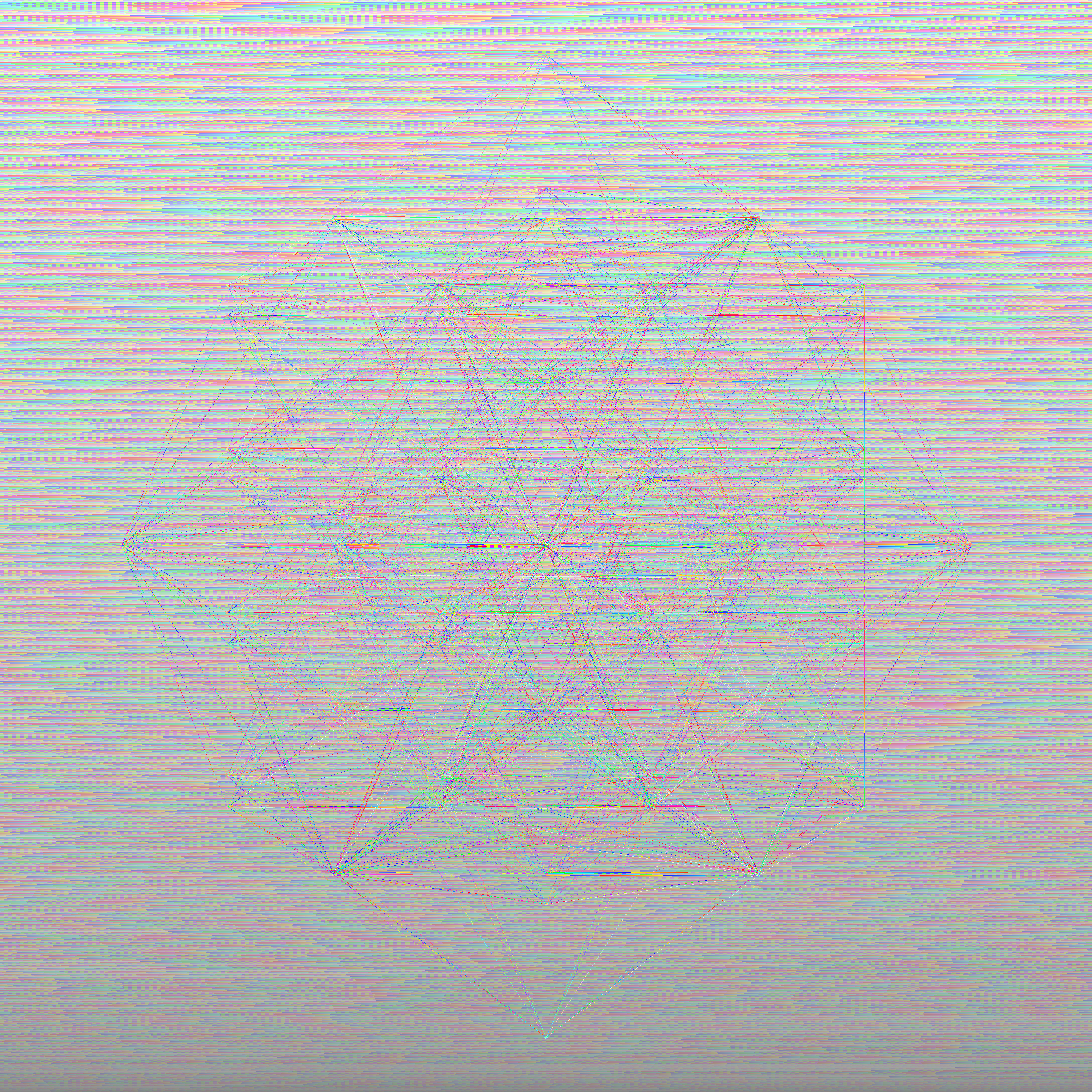


Just like Surfer Dude, this image was inspired by Garrett Lisi’s An Exceptionally Simple Theory of Everything. This one represents an E8 Petrie projection. The Python source was written with Chatgpt, and executed in Google Colab.
import numpy as np import colorsys import math from itertools import product from PIL import Image # === Configuration === SIZE = 4096 RADIUS = 6 # dot radius in pixels ALPHA_BG = 128 # 50% opacity for background ALPHA_FG = 255 # fully opaque for lines & dots TOTAL_PIXELS = SIZE * SIZE TOTAL_COLORS = 2**24 # 16,777,216 # === 1) Generate the 240 E₈ roots in ℝ⁸ === roots = [] # A-type: ±e_i ± e_j for i in range(8): for j in range(i+1, 8): v = np.zeros(8, dtype=float) v[i], v[j] = 1, -1 roots.append(v.copy()); roots.append((-v).copy()) v[i], v[j] = 1, 1 roots.append(v.copy()); roots.append((-v).copy()) # B-type: (±½,…,±½) with product(signs) = +1 for signs in product([1, -1], repeat=8): if np.prod(signs) == 1: roots.append(np.array(signs, dtype=float) * 0.5) roots = np.vstack(roots) # shape (240,8) # === 2) Project into 2D via PCA/SVD === roots_centered = roots - roots.mean(axis=0) U, S, Vh = np.linalg.svd(roots_centered, full_matrices=False) proj2d = roots_centered @ Vh.T[:, :2] # (240,2) # === 3) Scale & translate into pixel coordinates === marg = 0.05 * SIZE scale = (SIZE/2 - marg) / np.max(np.linalg.norm(proj2d, axis=1)) coords_f = proj2d * scale + SIZE/2 # floats coords = np.round(coords_f).astype(int) # === 4) Find all edges (⟨α,β⟩ = 1) === gram = roots @ roots.T i_u, j_u = np.where(np.triu(np.isclose(gram, 1.0), k=1)) edges = list(zip(i_u.tolist(), j_u.tolist())) # === 5) Bresenham line algorithm === def bresenham(x0, y0, x1, y1): dx = abs(x1 - x0); sx = 1 if x0 < x1 else -1 dy = abs(y1 - y0); sy = 1 if y0 < y1 else -1 err = dx - dy pixels = [] while True: pixels.append((x0, y0)) if x0 == x1 and y0 == y1: break e2 = 2 * err if e2 > -dy: err -= dy x0 += sx if e2 < dx: err += dx y0 += sy return pixels # === 6) Generate circle mask offsets for dots === circle_offsets = [] for dy in range(-RADIUS, RADIUS + 1): dx_max = int(math.floor(math.sqrt(RADIUS*RADIUS - dy*dy))) for dx in range(-dx_max, dx_max + 1): circle_offsets.append((dx, dy)) # === 7) Collect pixel coordinates for lines & dots === used = np.zeros((SIZE, SIZE), dtype=bool) line_pixels = [] for i, j in edges: x0, y0 = coords[i]; x1, y1 = coords[j] for (x, y) in bresenham(x0, y0, x1, y1): if not used[y, x]: line_pixels.append((x, y)) used[y, x] = True dot_pixels = [] for x0, y0 in coords: for dx, dy in circle_offsets: x, y = x0 + dx, y0 + dy if 0 <= x < SIZE and 0 <= y < SIZE and not used[y, x]: dot_pixels.append((x, y)) used[y, x] = True N_line = len(line_pixels) N_dot = len(dot_pixels) N_bg = TOTAL_PIXELS - N_line - N_dot assert N_bg + N_line + N_dot == TOTAL_PIXELS, "Pixel count mismatch!" # === 8) Build & sort full 24-bit palette by HSV (v, s descending) === # Create array of shape (16_777_216, 3) palette = np.empty((TOTAL_COLORS, 3), dtype=np.uint8) idxs = np.arange(TOTAL_COLORS, dtype=np.uint32) palette[:, 0] = (idxs >> 16) & 0xFF palette[:, 1] = (idxs >> 8) & 0xFF palette[:, 2] = (idxs ) & 0xFF # Convert to HSV # scaled to [0,1] floats rgb_norm = palette.astype(float) / 255.0 hsv = np.array([colorsys.rgb_to_hsv(*c) for c in rgb_norm]) v = hsv[:, 2] s = hsv[:, 1] # Sort so brightest & most saturated first: order = np.lexsort((-(s), -(v))) sorted_palette = palette[order] # === 9) Assign colors to lines, dots, and background === line_colors = sorted_palette[:N_line] dot_colors = sorted_palette[N_line:N_line+N_dot] bg_colors = sorted_palette[N_line+N_dot:] # === 10) Create RGBA image and paint === img = Image.new("RGBA", (SIZE, SIZE)) pixels = img.load() # Paint lines for (x, y), (r, g, b) in zip(line_pixels, line_colors): pixels[x, y] = (int(r), int(g), int(b), ALPHA_FG) # Paint dots for (x, y), (r, g, b) in zip(dot_pixels, dot_colors): pixels[x, y] = (int(r), int(g), int(b), ALPHA_FG) # Paint background bg_iter = iter(bg_colors) for y in range(SIZE): for x in range(SIZE): if not used[y, x]: r, g, b = next(bg_iter) pixels[x, y] = (int(r), int(g), int(b), ALPHA_BG) # === 11) Save PNG === img.save("E8_Petrie_exact24bit_4096.png") print("✅ Generated 4096×4096 E₈ Petrie projection using every 24-bit RGB color exactly once.")
| Date | |
|---|---|
| Colors | 16,777,216 |
| Pixels | 16,777,216 |
| Dimensions | 4,096 × 4,096 |
| Bytes | 8,107,597 |
